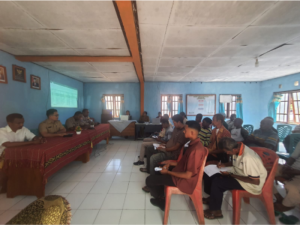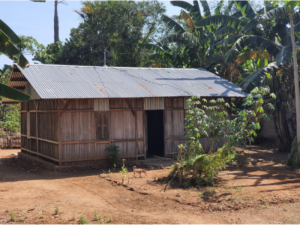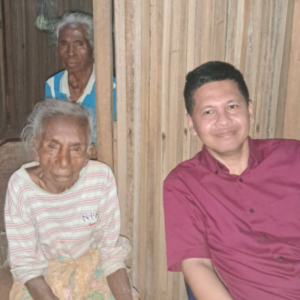Dr. Vidhyandika D. Perkasa, MSc, a lecturer at the Cultural and Media Studies program (KBM) at Gadjah Mada University (UGM), together with two KBM students, Rizky Indra Dewangga, S.Ant. and Salsabila Azzahra, S.I.Kom., conducted a research study titled “The Cultural Poverty of Ex-East Timorese Refugees and the Problem of Village Fund Redistribution: A Case Study on the Border of East Nusa Tenggara.” This research was funded by the “2024 Research Grant for Lecturers, Graduate School” scheme under the theme “Transformation Towards a Sovereign Indonesia.” The focus of this study aligns with the first goal of the Sustainable Development Goals (SDGs), “No Poverty.”
The research was conducted in two villages in Belu Regency, East Nusa Tenggara Province (NTT): Sadi Village and Silawan Village. The selection of these two villages was based on the high concentration of ex-East Timorese refugee communities and the significant poverty levels in these areas. Belu Regency, with its capital in Atambua, is located 274.5 km from Kupang City and can be reached in approximately 6.5 hours by land, traversing winding roads. An alternative route is by air using Wings Air’s ATR 72 aircraft, although this option is often considered less practical due to frequent cancellations or delays.
The 2024 report from the NTT Provincial Statistics Agency (BPS) highlights the region’s poverty rate, sharply above the national average, standing at 19.96% in 2023. The researchers’ interest in this topic stemmed from a deep concern for the lives of ex-East Timorese refugees who continue to live in poverty. The major question raised is why they remain impoverished despite having been legally recognized as Indonesian citizens since 1999/2000. Could this be due to ineffective policies?
Historically, since the conflict and following the referendum on August 30, 1999, it is estimated that 450,000 people were victims of the violence associated with the referendum. Among them, 240,000 were cross-border refugees who fled to West Timor (now NTT Province), while 210,000 experienced socio-political exclusion within East Timor—classified as Internally Displaced Persons (IDPs) (Wassel 2014:3; UNHCR 2002). They fled to Indonesia primarily for safety reasons. According to Achmad (2013), the number of refugees was far beyond the NTT Provincial Government’s expectations, complicating the management of refugee camps. The status of refugees clearly exacerbated their vulnerability and worsened their poverty conditions.
The field research was conducted from June 24-29, 2024. Due to a flight delay, the researchers arrived in Atambua at around 10:00 PM WITA. The following day, they held a meeting with local assistants responsible for scheduling interviews with several informants in both Sadi and Silawan Villages. The researchers then met with the head of Sadi Village to explain the purpose of the study and seek permission to interview several residents. During this meeting, the researchers also gathered valuable information from the village head. The distance between Sadi Village and Atambua is 10 kilometers, approximately an 18-minute drive. On that day, the researchers also attended a village meeting for poverty data updating, which was highly relevant to their study. The atmosphere in Sadi Village was hot and dry, with most houses roofed with zinc and coconut leaves, and walls made of wood or bamboo.
 Image 1. Meeting in Sadi Village regarding poverty data updating.
Image 1. Meeting in Sadi Village regarding poverty data updating.
 Image 2. A house of an ex-East Timorese refugee resident in Sadi Village.
Image 2. A house of an ex-East Timorese refugee resident in Sadi Village.
While conducting data collection in Sadi Village, the researchers interviewed both the native residents and the ex-East Timorese refugees. This was intended to observe interactions between the two social groups. Surprisingly, several informants, particularly the elderly, could not speak Indonesian, requiring local residents to translate from Kemak language to Indonesian. The majority of Sadi residents are farmers who rely heavily on rainwater to irrigate their fields.
 Image 3. An elderly ex-East Timorese refugee informant in Sadi Village who cannot speak Indonesian.
Image 3. An elderly ex-East Timorese refugee informant in Sadi Village who cannot speak Indonesian.
Through visual observation and in-depth interviews with informants in Sadi Village, the main source of their poverty was identified: drought. Drought, driven by climate change and inadequate irrigation systems, often leads to crop failure. The community also relies on water purchased from mobile tank trucks for daily needs.
Another factor contributing to poverty is traditional customs, particularly regarding funerals, engagements, and weddings. Communities are expected to provide pigs, goats, or cattle as part of their contribution to such events. There is a sense of pride and shame associated with failing to meet these expectations, with some even fearing karma or curses if they do not contribute. People rely heavily on family support for these obligations, but if family support is unavailable, they often resort to debt.
The study also found that limited job opportunities contribute to poverty in Sadi Village. High school and university graduates often have to seek employment outside Belu Regency. In addition to the limited job market, many informants interviewed were elderly with limited educational backgrounds, making it even harder for them to secure formal employment. As a result, the only viable options for meeting their needs are through self-employment, such as farming, fishing, or running small shops. However, the researchers observed little government intervention to improve the situation. Assistance received, such as rice and the Family Hope Program (PKH) cash aid of IDR 300,000/month, is inconsistent. Some residents received fiber water tanks from the government, but during the dry season, they still need to buy water independently. (To be continued to Part 2)
 Image 4. Interview with an ex-East Timorese refugee resident in Sadi Village inside their house
Image 4. Interview with an ex-East Timorese refugee resident in Sadi Village inside their house
References:
Achmad, J. (2013). East Timorese Refugees in West Timor,dalam buku Destruction and Reconstruction of East Timor, editor James J. Fox dan Dionisio Babo Soares, edt. 2000. ANU Press, Canberra.
BPS Provinsi NTT. (2024). Provinsi Nusa Tenggara Timur Dalam Angka 2024 (53000.24005)
UNHCR. (2002). East Timorese Refugees in West Timor. Global Appeal (Addendum).
Wassel, T. (2014). Timor Leste: Links Between Peacebuilding, Conflict Prevention and Durable Solutions to Displacement. Brooking-LSE: Project of Internally Displacement
Contributors: Dr. Vidhyandika D. Perkasa, M.Sc, Rizky Indra Dewangga, Salsabila Azzahra
